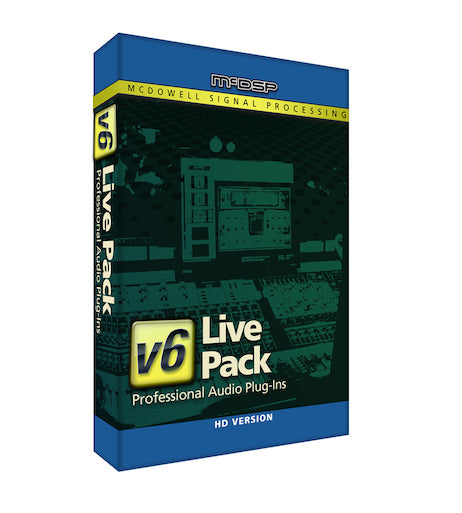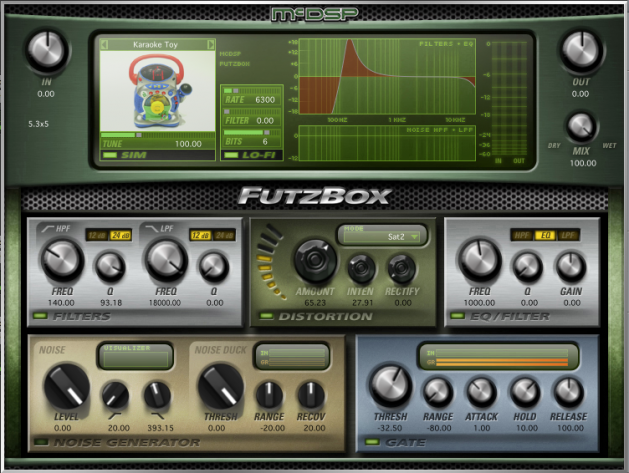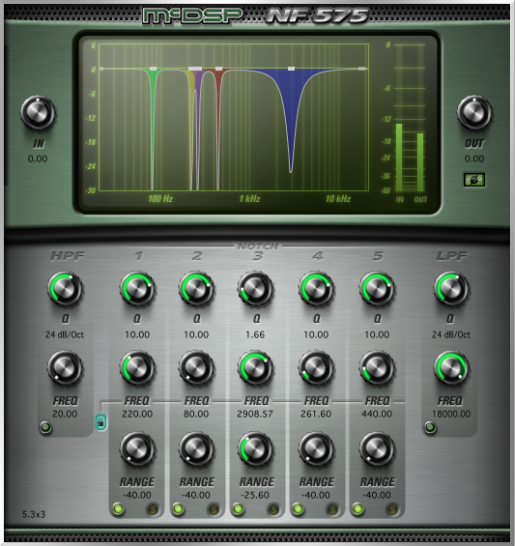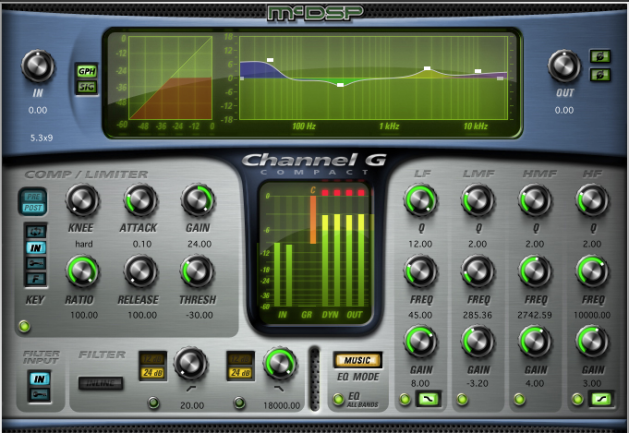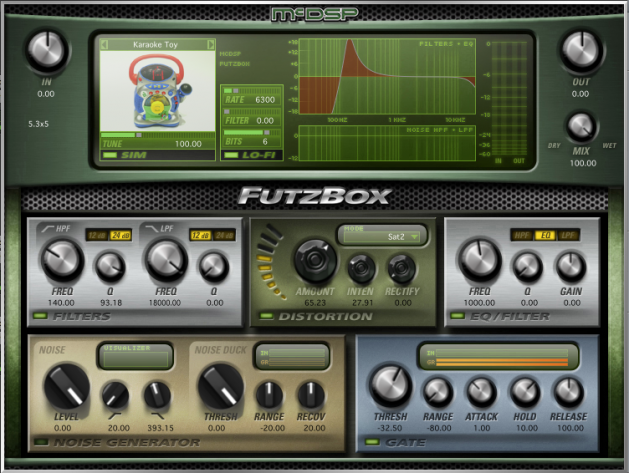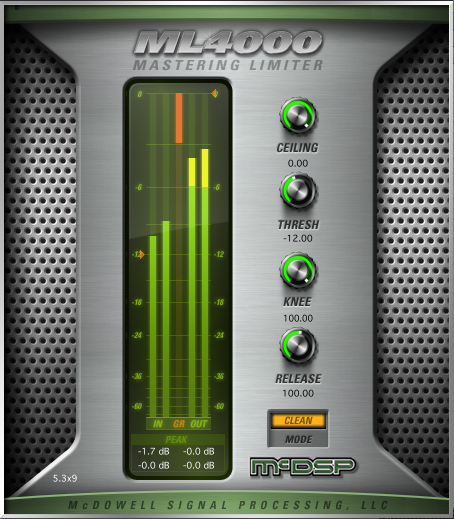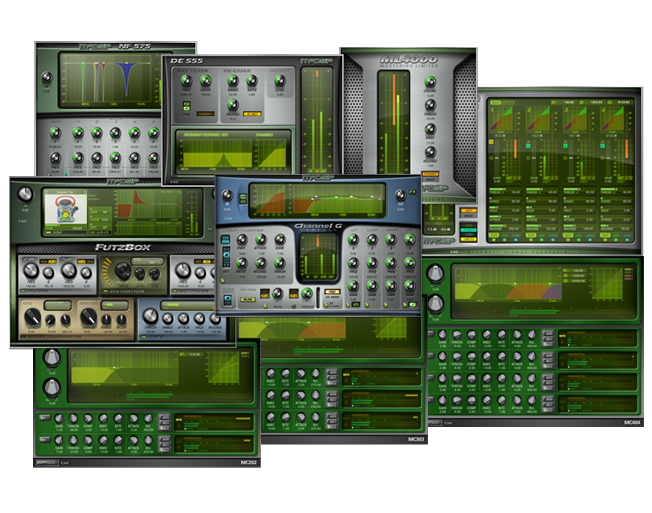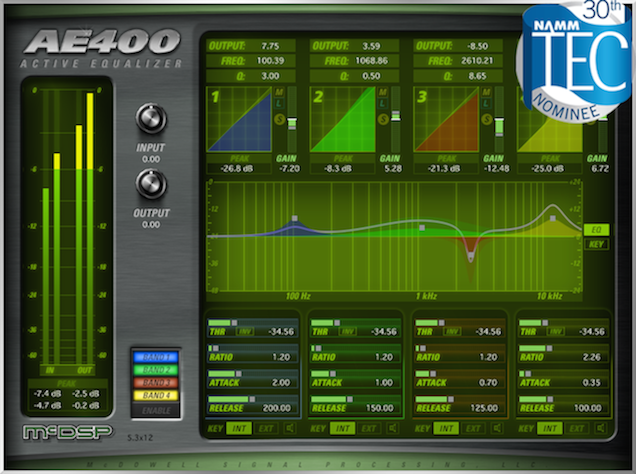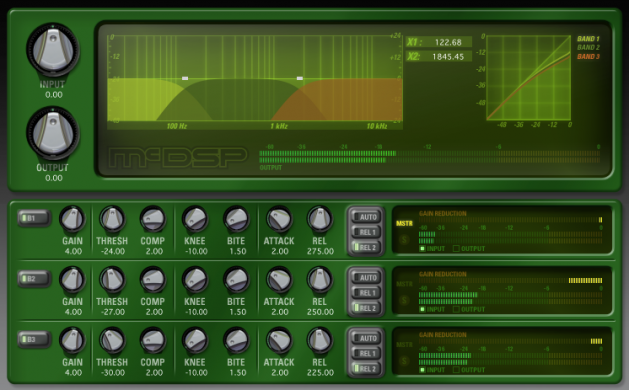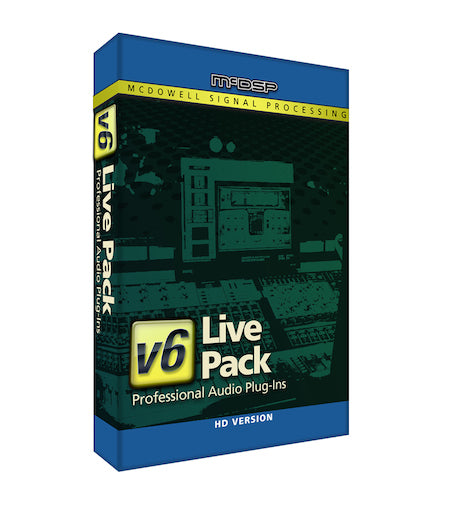
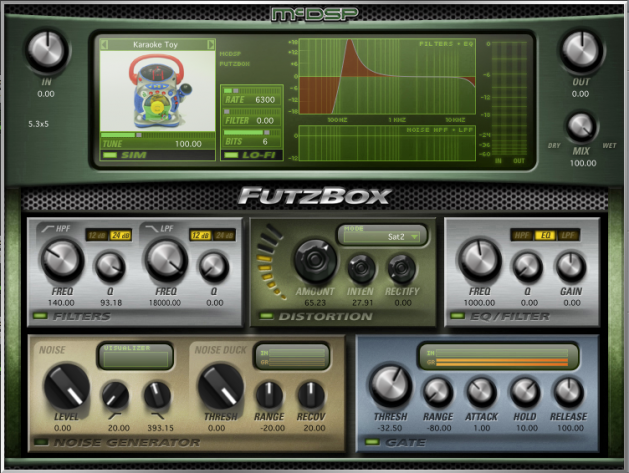
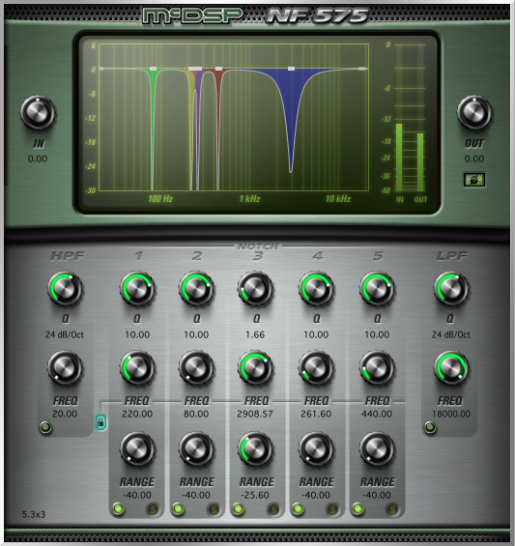
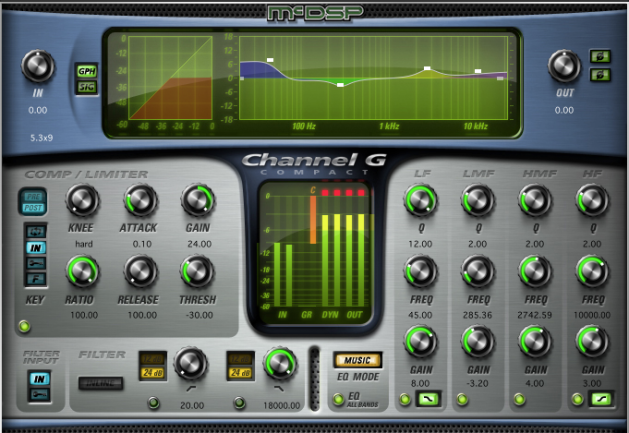
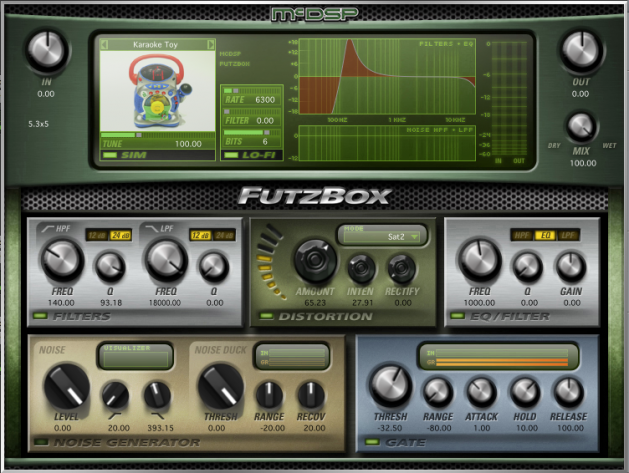
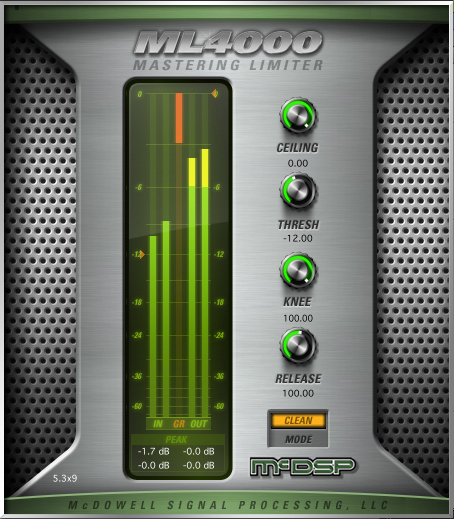
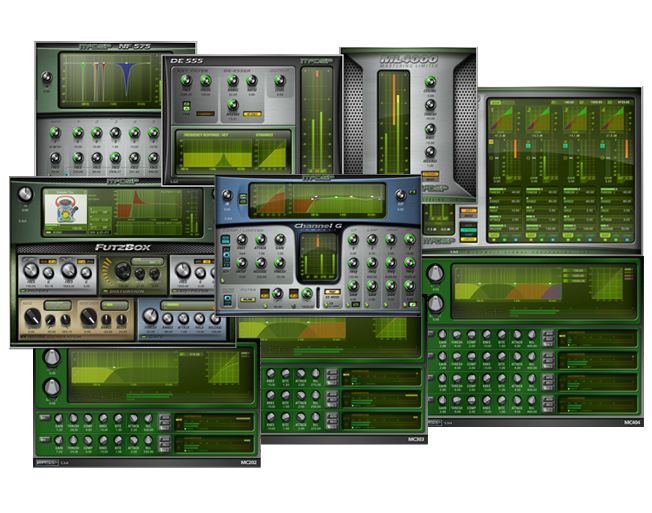
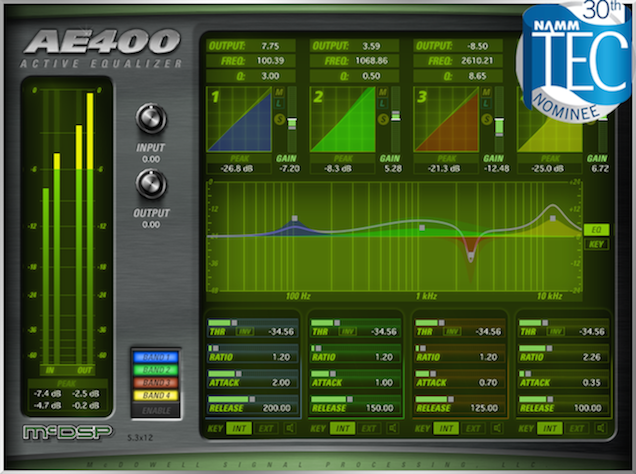
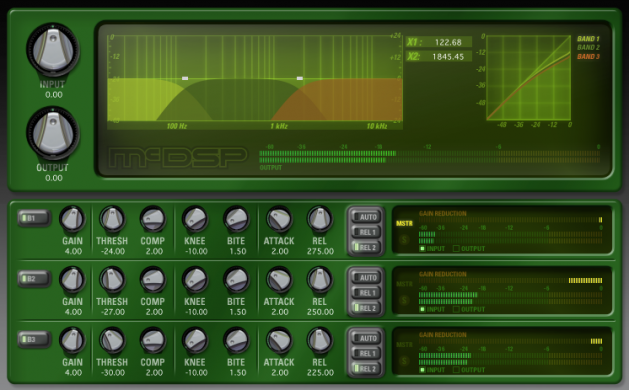
- Details
- Features
- Reviews
McDSP is proud to introduce Live Pack, a collection of highly acclaimed plug-ins for mixing live performances. Features like ultra low latency, superior sonic flexibility and seamless integration with the Avid VENUE live sound system make Live Pack a must-have for any FOH or monitoring engineer.
In addition to supporting the Avid VENUE systems (S3L, S3L-X) Live Pack plug-ins also run as AAX DSP/Native formats on Pro Tools HD, LE, and M-Powered systems, as well as on any Audio Units or VST compatible DAW.
Includes
- AE400
- SA-2 Dialog Processor
- Channel G Compact
- DE555
- FutzBox
- MC2000
- ML4000
- NF575
AE400 Active EQ
The AE400 is made up of 4 bands of fixed and active equalization. Each band is completely overlapping with all other bands and has its own Q (bandwidth), fixed gain, and active gain controls. A key filter for each band allows the active gain response to be as selective or broad as needed, based on the Q (bandwidth) control. Each band can use the input signal or selected side chain signal to trigger the active EQ response.
The active EQ bands can be controlled via the response plot itself, or from the text readouts above and below the response plot. The AE400’s active EQ response is determined by each band’s threshold, attack and release settings. Additionally, a ratio control determines input signal level sensitivity to further articulate how the active EQ will reach maximum active equalization – a feature unique to the AE400.
Peak signal text readouts for each active EQ band’s key signal allow quick setup of each band’s active EQ threshold, and are located underneath band dynamics plots. Input and Output controls, individual band bypass, band control linking, and band key signal monitoring round out the features of the AE400.
SA-2 Dialog Processor
Dialog. The focal point of any movie, television show, documentary, or for that matter, any creative media production involving the spoken word. Add to the mix a sweeping musical score, dozens of foley effects, and plenty more – and it becomes clear the job of dialog mixing is a tall order. After all, if you can’t hear what the actors are saying, why watch it at all!!
The SA-2 Dialog Processor is based on hardware originally conceived by Academy Award winning re-recording mixer Mike Minkler and used on over 100 major motion pictures. The SA-2 is designed to improve the overall sound of recorded speech. But the SA-2 is not just for dialog. It’s equally useful for vocals, and is a great tool for adjusting the timbre of any track, a reliable de-esser, and a fine multi-frequency compressor, in our completely biased opinion.
The SA-2 Dialog Processor is made up of 5 bands of strategic active equalization, configured in a variety of modes to best address common issues of dialog. Each band of active equalization has a threshold control to determine at what signal level the active equalizer begins to effect the signal. There are also enable buttons for each band to quickly audition the effect of any given band. Two mode selectors – one for controlling the ballistics of the active equalization, and a second for placing the five bands at strategic locations in the frequency spectrum. Finally, there are input and output gain controls for overall adjustment.
Channel G Compact
Channel G Compact delivers the same sonic experience as Channel G with a smaller dsp footprint.
Channel G Compact features calibration modes for music, post production, and models of the world’s most popular analog mixing desks.
The Channel G Compact HD user interface seamlessly integrates with the Avid D-Control and D-Command control surfaces, as well as the Venue D-Show and Profile live sound consoles.
DE555
The DE555 is a new generation of de-essing technology, providing transparent, precise de-essing with unique flexibility.
Intelligent signal analysis allows the DE555 to effectively de-ess at any signal level – no manual input threshold adjustment required.
Other options include continuously adjustable ratio and release controls to fine- tune the de-essing amount, plus a high frequency (HF) only mode for reducing the signal level of only the ‘sss’ and not the original dialog.
Key filter options include high pass and band pass filtering. A unique focus control further enhances the key filter’s ability to separate ‘essing’ from actual dialog. The key filter output can also be monitored.
Real-time displays of de-essing amounts and key filter response enable quick and easy setup.
FutzBox
FutzBox is a distortion and noise generator plug-in for creating low fidelity versions of audio signals.
Typical post productions require distorted, or ‘futzed’ versions of dialog and other tracks. Simulations of radios, cell phones, and televisions are now available in a single software product. These simulations, called SIMs (Synthetic Impulse Models) provide accurate modeling in an extremely optimized format, allowing FutzBox to use less DSP power than conventional convolution based products. Furthermore, SIMs can be scaled in real-time and changed on the fly.
In addition to the SIM library of sounds, FutzBox also includes filtering and EQ, distortion, a noise generator, and gating to complete the sonic destruction required. Original and distorted audio can be mixed in real-time to accommodate scene changes or other automation requirements.
MC2000 Multi-Band Compressor
The MC2000 is a high-end multi-band compressor plug-in designed to emulate the sounds of vintage and modern compressors.
MC2000 is 3 plug-ins:
- MC202 – two-band compression
- MC303 – three-band compression
- MC404 – four-band compression
The MC2000 gives the user complete control of multi-band dynamic compression. Common controls such as output (make-up gain), threshold, compression (ratio), attack, and release are provided. Non-standard Knee and BITE controls allow unique and unprecedented articulation of compression characteristics. Multiple peak detection circuit types provide flexibility only previously achieved by owning several compression units. Steep 24 dB/Oct crossover filters minimize signal leakage into adjacent compression bands.
ML4000 Mastering Limiter
The ML4000 is a high-resolution limiter and multi-band dynamics processor designed for music, mastering, post, and live sound.
The ML4000 is two plug-ins:
- ML1 – mastering limiter
- ML4 – multi-band Gate, Expander, and Compressor fed into the ML1 mastering limiter
The ML1 mastering limiter uses a flexible brick wall look-ahead design coupled with multiple stages of limiting for superior peak detection. The unique Knee and Mode controls allow the ML1 to handle any kind of material with a variety of responses ranging from transparent to aggressive.
The ML4 multi-band dynamics processor includes a 4-band Gate, Expander (upwards or downwards), and Compressor fed into the same limiter algorithm found in the ML1. Each band’s Gate, Expander, and Compressor can be configured separately or linked together. Steep 24 dB/Oct crossover filters minimize signal leakage into adjacent bands. Multiple real-time metering options in each band allow quick visualization of all signal dynamics.
The ML4 crossover page shows the overall frequency response in real-time of the input, output, or total dynamics effect, on top of the graphically adjustable crossover frequencies. Accurate output adjustment is fast and simple with output ceiling control, large meters, and meter level text readouts.
The ML4000 provides outstanding results with an intuitive user interface, flexible design, and powerful set of algorithms.
NF575 Noise Filter
Accurate high pass and low pass filters reduce low frequency rumble and high frequency hiss. Selectable slopes of 6, 12, 18, 24, 30 and 36 dB/Oct and frequency control range covering the entire audible spectrum make the NF575 filters extremely flexible.
Advanced notch filters allow the user to select the amount of signal cut, cut frequency, and width (Q). All five NF575 notch filters can be linked harmonically to address common cyclical noise problems such as 60 Hz hum.
Noise Filtering and the NF575
The NF575 Noise Filter is a specially designed set of algorithms used to remove noise (but not music!) from audio signals. This issue covers basic operations of the NF575 Noise Filter, provides a more in depth description of some of its features, and outlines some useful applications.
Basics
Filters can be broken down into four general categories – high pass, low pass, band stop (notch), and band pass.
High Pass Filter (HPF)
High pass filters remove signals below the selected frequency, and pass the signals above the selected frequency unaffected (hence the term high pass). High pass filters have a slope measured in the amount of signal reduction (in dB) per frequency octave. Typically these values are in multiples of 6 dB/Oct. At the exact selected frequency of the high pass filter the signal reduction is usually -3 dB, however this can change based on filter design.
A high pass filter is useful for removing low frequency rumble, unwanted vocal plosives, and dc offsets.
Low Pass Filter (LPF)
Low pass filters remove signals above the selected frequency, and pass the signals below the selected frequency unaffected (hence the term low pass). Low pass filters have a slope measured in the amount of signal reduction (in dB) per frequency octave. Typically these values are in multiples of 6 dB/Oct. At the exact selected frequency of the low pass filter the signal reduction is usually -3 dB, however this can change based on filter design.
A low pass filter is useful for background noise such as tape hiss, waterfalls and general ambient background noise.
Band Stop Filter
Band stop filters, or notch filters, are designed to remove a specified amount of signal at exactly the selected frequency. Band stop (notch) filters have a slope, or Q control, that determines the width of the actual notch shape. A Q of 1.0 is about one frequency octave. A Q of 12.0 is about 1/12 a frequency octave, or one semi-tone. At the exact selected frequency of the band stop (notch) filter the signal reduction is maximum. Some band stop (notch) filters, like those found on the NF575, allow user adjustment of the amount of signal reduction. This signal reduction adjustment is commonly referred to as range on noise filters.
A band stop (notch) is useful for removing cyclical noise like 60 Hz hum and camera shutter noise.
A Closer Look at the NF575 Plug-In
Now that we’ve covered some filter type basics, some features of the NF575 Noise Filter could use some more discussion.
Filter Slopes
Although there are several filtering options available for the Pro Tools™ platform, few, if any, have the precision of the NF575 Noise Filter. Not only designed for the ultimate in filtering accuracy, the high pass and low pass filters included in the NF575 have adjustable slopes with settings from 6 dB/Oct up to 36 dB/Oct. Because of the steepness of the NF575 Noise Filter high pass and low pass filters, even greater amounts of noise reduction are possible. The steep transition (slope) between unaffected and filtered frequencies allows even tighter control over audio signals and the noise removal process.
Notch Filter Soloing
Great notch filtering is nearly useless if the removed noise cannot be monitored accurately. The NF575 notch filter Solo buttons insert band pass filters in place of the notch filters, so the user can audition cyclical noise sources over a selectable frequency bandwidth.
When a notch filter band is soloed, the user is effectively listening to the removed signal. Note the Solo control only solos the filter band by as much as the selected Range value. When the Range control is at its maximum reduction, the band will be soloed the most. When the Range control is at its minimum reduction (no reduction) the Solo control has no effect.
For each notch filter band, soloing that band and sweeping it across its available frequency control range will reveal at what frequency the noise source is the loudest. Upon finding this loudest frequency location, un-solo the notch filter. Now that cyclical noise is removed from the audio signal. Adjust the Q control as tightly as possible to remove only the noise and not the desired audio data. Repeat this process for all notches, or until all audible cyclical noise is removed.
Notch Filter Linking
Sometimes the cyclical noise has a fundamental frequency, but the harmonics of the periodic noise also contaminate the audio. By linking all the notch filter frequencies to the first notch filter band in the NF575, cyclical noise can be quickly removed. Default settings put the notch filter frequencies at harmonic intervals automatically (ex: 60, 120, 180, 240, 300 Hz). If the noise does not contain harmonics, but rather seemingly unrelated cyclical noises at various frequencies, the NF575 notch filters can be linked at any frequency interval (ex: 120, 168, 240, 328, 400 Hz).
Applications
But what would you use the NF575 for? Why, noise removal of course! Here are some common (and not so common) examples of how to apply the NF575 Noise Filter in your next session.
60 Hz Buzz Removal
Cyclical noise like AC power hum is all too common in audio production. While a simple notch filter may remove some of this kind of noise, there are often several harmonics of noise that require multiple notch filters, often with varying amounts of reduction. The NF575 notch filters are extremely narrow and linkable, so the removal of cyclical (and harmonic) noise is possible, without affecting the desired audio.
Camera Shutter Noise
Camera noise can sometimes generate cyclical (and harmonic) noise problems as well. The use of the NF575 notch filters and their linking capability can make quick work of this kind of noise problem.
Low Frequency Rumble
Vocal or dialog plosives (ex: a really loud ‘buh’ sound when screaming ‘baby’ at the top of your lungs), the rumble from a mic stand, wind, or other low frequency signals can spoil the otherwise good recording. Using the NF575 high pass filters, these types of sounds can be easily removed. The steeper slopes can remove more of these unwanted sounds, while preserving the real content in the track.
Phaser Effects
While the NF575 is really designed for noise reduction, the NF575 notch filters can create some pretty drastic phaser like effects. Link all 5 notch filters to the first notch using the link control, select a wide Q setting, and then vary the frequency control in the first notch filter (band 1). The effects are interesting, and by automating the frequency control of the first notch filter, the phaser sweep can be made into a consistent effect during playback (instead of locking to the rate of an LFO, which could produce different phasor effects each playback pass).
| Product Name | McDSP Live Pack HD |
|---|---|
| Brand | MCDSP |
| Condition | New |
| MPN | M-B-LP-E |
| Shipping Option | Electronic Delivery |
Channel G Compact
- High pass and low pass filters with selectable slopes of up 12 and 24 dB/Oct
- Full featured Compressor/Limiter
- Four-band EQ with shelving and parametric sections
- Compressor/Limiter operation pre or post EQ section
- Analog Saturation modeling
- Double precision processing
- Ultra low latency
- Mono and stereo versions
DE555 De-Esser
- Advanced de-essing technology
- Unique key filter focus and de-essing controls
- Real-time metering and key filter response plot
- High frequency (HF) only option
- Double precision processing
- Ultra low latency
- Mono and stereo versions
FutzBox
- Library of Synthetic Impulse Models (SIMs)
- Configurable ‘futz’ effects including filtering, EQ, and distortion
- Flexible noise generator with ducking capability
- Hyper-sensitive gate for signal dropout effects
- Double precision processing
- Ultra low latency
- Mono and stereo versions
MC2000 Multi-Band Compressor
- Compression curve modeling
- Multiple peak detection circuits
- Adjustable crossover filters
- Multi-band control linking
- Analog Saturation modeling
- Double precision processing
- Ultra low latency
- Mono and stereo versions
ML4000 Mastering Limiter
- Brick wall look-ahead limiter
- Multi-stage peak detection and limiting
- Unique limiter Knee and Mode controls
- Multi-band Gate, Expander (up/down), Compressor
- Simultaneous display of Gate, Expander, and Compressor dynamic curves in every band
- Multiple real-time metering options
- Adjustable crossover filters
- Multi-band control linking
- Analog Saturation modeling
- Double precision processing
- Ultra low latency
- Mono and stereo versions
NF575 Noise Filter
- High Pass Filtering (HPF) with slopes up to 36 dB/Oct
- Low Pass Filtering (LPF) with slopes up to 36 dB/Oct
- Five bands of notch filtering with linkable frequency control
- Analog Saturation modeling
- Double precision processing
- Ultra low latency
- Mono and stereo versions
McDSP Live Pack HD
McDSP is proud to introduce Live Pack, a collection of highly acclaimed plug-ins for mixing live performances. Features like ultra low latency, superior sonic flexibility and seamless integration with the Avid VENUE live sound system make Live Pack a must-have for any FOH or monitoring engineer.
In addition to supporting the Avid VENUE systems (S3L, S3L-X) Live Pack plug-ins also run as AAX DSP/Native formats on Pro Tools HD, LE, and M-Powered systems, as well as on any Audio Units or VST compatible DAW.
Includes
- AE400
- SA-2 Dialog Processor
- Channel G Compact
- DE555
- FutzBox
- MC2000
- ML4000
- NF575
AE400 Active EQ
The AE400 is made up of 4 bands of fixed and active equalization. Each band is completely overlapping with all other bands and has its own Q (bandwidth), fixed gain, and active gain controls. A key filter for each band allows the active gain response to be as selective or broad as needed, based on the Q (bandwidth) control. Each band can use the input signal or selected side chain signal to trigger the active EQ response.
The active EQ bands can be controlled via the response plot itself, or from the text readouts above and below the response plot. The AE400’s active EQ response is determined by each band’s threshold, attack and release settings. Additionally, a ratio control determines input signal level sensitivity to further articulate how the active EQ will reach maximum active equalization – a feature unique to the AE400.
Peak signal text readouts for each active EQ band’s key signal allow quick setup of each band’s active EQ threshold, and are located underneath band dynamics plots. Input and Output controls, individual band bypass, band control linking, and band key signal monitoring round out the features of the AE400.
SA-2 Dialog Processor
Dialog. The focal point of any movie, television show, documentary, or for that matter, any creative media production involving the spoken word. Add to the mix a sweeping musical score, dozens of foley effects, and plenty more – and it becomes clear the job of dialog mixing is a tall order. After all, if you can’t hear what the actors are saying, why watch it at all!!
The SA-2 Dialog Processor is based on hardware originally conceived by Academy Award winning re-recording mixer Mike Minkler and used on over 100 major motion pictures. The SA-2 is designed to improve the overall sound of recorded speech. But the SA-2 is not just for dialog. It’s equally useful for vocals, and is a great tool for adjusting the timbre of any track, a reliable de-esser, and a fine multi-frequency compressor, in our completely biased opinion.
The SA-2 Dialog Processor is made up of 5 bands of strategic active equalization, configured in a variety of modes to best address common issues of dialog. Each band of active equalization has a threshold control to determine at what signal level the active equalizer begins to effect the signal. There are also enable buttons for each band to quickly audition the effect of any given band. Two mode selectors – one for controlling the ballistics of the active equalization, and a second for placing the five bands at strategic locations in the frequency spectrum. Finally, there are input and output gain controls for overall adjustment.
Channel G Compact
Channel G Compact delivers the same sonic experience as Channel G with a smaller dsp footprint.
Channel G Compact features calibration modes for music, post production, and models of the world’s most popular analog mixing desks.
The Channel G Compact HD user interface seamlessly integrates with the Avid D-Control and D-Command control surfaces, as well as the Venue D-Show and Profile live sound consoles.
DE555
The DE555 is a new generation of de-essing technology, providing transparent, precise de-essing with unique flexibility.
Intelligent signal analysis allows the DE555 to effectively de-ess at any signal level – no manual input threshold adjustment required.
Other options include continuously adjustable ratio and release controls to fine- tune the de-essing amount, plus a high frequency (HF) only mode for reducing the signal level of only the ‘sss’ and not the original dialog.
Key filter options include high pass and band pass filtering. A unique focus control further enhances the key filter’s ability to separate ‘essing’ from actual dialog. The key filter output can also be monitored.
Real-time displays of de-essing amounts and key filter response enable quick and easy setup.
FutzBox
FutzBox is a distortion and noise generator plug-in for creating low fidelity versions of audio signals.
Typical post productions require distorted, or ‘futzed’ versions of dialog and other tracks. Simulations of radios, cell phones, and televisions are now available in a single software product. These simulations, called SIMs (Synthetic Impulse Models) provide accurate modeling in an extremely optimized format, allowing FutzBox to use less DSP power than conventional convolution based products. Furthermore, SIMs can be scaled in real-time and changed on the fly.
In addition to the SIM library of sounds, FutzBox also includes filtering and EQ, distortion, a noise generator, and gating to complete the sonic destruction required. Original and distorted audio can be mixed in real-time to accommodate scene changes or other automation requirements.
MC2000 Multi-Band Compressor
The MC2000 is a high-end multi-band compressor plug-in designed to emulate the sounds of vintage and modern compressors.
MC2000 is 3 plug-ins:
- MC202 – two-band compression
- MC303 – three-band compression
- MC404 – four-band compression
The MC2000 gives the user complete control of multi-band dynamic compression. Common controls such as output (make-up gain), threshold, compression (ratio), attack, and release are provided. Non-standard Knee and BITE controls allow unique and unprecedented articulation of compression characteristics. Multiple peak detection circuit types provide flexibility only previously achieved by owning several compression units. Steep 24 dB/Oct crossover filters minimize signal leakage into adjacent compression bands.
ML4000 Mastering Limiter
The ML4000 is a high-resolution limiter and multi-band dynamics processor designed for music, mastering, post, and live sound.
The ML4000 is two plug-ins:
- ML1 – mastering limiter
- ML4 – multi-band Gate, Expander, and Compressor fed into the ML1 mastering limiter
The ML1 mastering limiter uses a flexible brick wall look-ahead design coupled with multiple stages of limiting for superior peak detection. The unique Knee and Mode controls allow the ML1 to handle any kind of material with a variety of responses ranging from transparent to aggressive.
The ML4 multi-band dynamics processor includes a 4-band Gate, Expander (upwards or downwards), and Compressor fed into the same limiter algorithm found in the ML1. Each band’s Gate, Expander, and Compressor can be configured separately or linked together. Steep 24 dB/Oct crossover filters minimize signal leakage into adjacent bands. Multiple real-time metering options in each band allow quick visualization of all signal dynamics.
The ML4 crossover page shows the overall frequency response in real-time of the input, output, or total dynamics effect, on top of the graphically adjustable crossover frequencies. Accurate output adjustment is fast and simple with output ceiling control, large meters, and meter level text readouts.
The ML4000 provides outstanding results with an intuitive user interface, flexible design, and powerful set of algorithms.
NF575 Noise Filter
Accurate high pass and low pass filters reduce low frequency rumble and high frequency hiss. Selectable slopes of 6, 12, 18, 24, 30 and 36 dB/Oct and frequency control range covering the entire audible spectrum make the NF575 filters extremely flexible.
Advanced notch filters allow the user to select the amount of signal cut, cut frequency, and width (Q). All five NF575 notch filters can be linked harmonically to address common cyclical noise problems such as 60 Hz hum.
Noise Filtering and the NF575
The NF575 Noise Filter is a specially designed set of algorithms used to remove noise (but not music!) from audio signals. This issue covers basic operations of the NF575 Noise Filter, provides a more in depth description of some of its features, and outlines some useful applications.
Basics
Filters can be broken down into four general categories – high pass, low pass, band stop (notch), and band pass.
High Pass Filter (HPF)
High pass filters remove signals below the selected frequency, and pass the signals above the selected frequency unaffected (hence the term high pass). High pass filters have a slope measured in the amount of signal reduction (in dB) per frequency octave. Typically these values are in multiples of 6 dB/Oct. At the exact selected frequency of the high pass filter the signal reduction is usually -3 dB, however this can change based on filter design.
A high pass filter is useful for removing low frequency rumble, unwanted vocal plosives, and dc offsets.
Low Pass Filter (LPF)
Low pass filters remove signals above the selected frequency, and pass the signals below the selected frequency unaffected (hence the term low pass). Low pass filters have a slope measured in the amount of signal reduction (in dB) per frequency octave. Typically these values are in multiples of 6 dB/Oct. At the exact selected frequency of the low pass filter the signal reduction is usually -3 dB, however this can change based on filter design.
A low pass filter is useful for background noise such as tape hiss, waterfalls and general ambient background noise.
Band Stop Filter
Band stop filters, or notch filters, are designed to remove a specified amount of signal at exactly the selected frequency. Band stop (notch) filters have a slope, or Q control, that determines the width of the actual notch shape. A Q of 1.0 is about one frequency octave. A Q of 12.0 is about 1/12 a frequency octave, or one semi-tone. At the exact selected frequency of the band stop (notch) filter the signal reduction is maximum. Some band stop (notch) filters, like those found on the NF575, allow user adjustment of the amount of signal reduction. This signal reduction adjustment is commonly referred to as range on noise filters.
A band stop (notch) is useful for removing cyclical noise like 60 Hz hum and camera shutter noise.
A Closer Look at the NF575 Plug-In
Now that we’ve covered some filter type basics, some features of the NF575 Noise Filter could use some more discussion.
Filter Slopes
Although there are several filtering options available for the Pro Tools™ platform, few, if any, have the precision of the NF575 Noise Filter. Not only designed for the ultimate in filtering accuracy, the high pass and low pass filters included in the NF575 have adjustable slopes with settings from 6 dB/Oct up to 36 dB/Oct. Because of the steepness of the NF575 Noise Filter high pass and low pass filters, even greater amounts of noise reduction are possible. The steep transition (slope) between unaffected and filtered frequencies allows even tighter control over audio signals and the noise removal process.
Notch Filter Soloing
Great notch filtering is nearly useless if the removed noise cannot be monitored accurately. The NF575 notch filter Solo buttons insert band pass filters in place of the notch filters, so the user can audition cyclical noise sources over a selectable frequency bandwidth.
When a notch filter band is soloed, the user is effectively listening to the removed signal. Note the Solo control only solos the filter band by as much as the selected Range value. When the Range control is at its maximum reduction, the band will be soloed the most. When the Range control is at its minimum reduction (no reduction) the Solo control has no effect.
For each notch filter band, soloing that band and sweeping it across its available frequency control range will reveal at what frequency the noise source is the loudest. Upon finding this loudest frequency location, un-solo the notch filter. Now that cyclical noise is removed from the audio signal. Adjust the Q control as tightly as possible to remove only the noise and not the desired audio data. Repeat this process for all notches, or until all audible cyclical noise is removed.
Notch Filter Linking
Sometimes the cyclical noise has a fundamental frequency, but the harmonics of the periodic noise also contaminate the audio. By linking all the notch filter frequencies to the first notch filter band in the NF575, cyclical noise can be quickly removed. Default settings put the notch filter frequencies at harmonic intervals automatically (ex: 60, 120, 180, 240, 300 Hz). If the noise does not contain harmonics, but rather seemingly unrelated cyclical noises at various frequencies, the NF575 notch filters can be linked at any frequency interval (ex: 120, 168, 240, 328, 400 Hz).
Applications
But what would you use the NF575 for? Why, noise removal of course! Here are some common (and not so common) examples of how to apply the NF575 Noise Filter in your next session.
60 Hz Buzz Removal
Cyclical noise like AC power hum is all too common in audio production. While a simple notch filter may remove some of this kind of noise, there are often several harmonics of noise that require multiple notch filters, often with varying amounts of reduction. The NF575 notch filters are extremely narrow and linkable, so the removal of cyclical (and harmonic) noise is possible, without affecting the desired audio.
Camera Shutter Noise
Camera noise can sometimes generate cyclical (and harmonic) noise problems as well. The use of the NF575 notch filters and their linking capability can make quick work of this kind of noise problem.
Low Frequency Rumble
Vocal or dialog plosives (ex: a really loud ‘buh’ sound when screaming ‘baby’ at the top of your lungs), the rumble from a mic stand, wind, or other low frequency signals can spoil the otherwise good recording. Using the NF575 high pass filters, these types of sounds can be easily removed. The steeper slopes can remove more of these unwanted sounds, while preserving the real content in the track.
Phaser Effects
While the NF575 is really designed for noise reduction, the NF575 notch filters can create some pretty drastic phaser like effects. Link all 5 notch filters to the first notch using the link control, select a wide Q setting, and then vary the frequency control in the first notch filter (band 1). The effects are interesting, and by automating the frequency control of the first notch filter, the phaser sweep can be made into a consistent effect during playback (instead of locking to the rate of an LFO, which could produce different phasor effects each playback pass).
| Product Name | McDSP Live Pack HD |
|---|---|
| Brand | MCDSP |
| Condition | New |
| MPN | M-B-LP-E |
| Shipping Option | Electronic Delivery |
Channel G Compact
- High pass and low pass filters with selectable slopes of up 12 and 24 dB/Oct
- Full featured Compressor/Limiter
- Four-band EQ with shelving and parametric sections
- Compressor/Limiter operation pre or post EQ section
- Analog Saturation modeling
- Double precision processing
- Ultra low latency
- Mono and stereo versions
DE555 De-Esser
- Advanced de-essing technology
- Unique key filter focus and de-essing controls
- Real-time metering and key filter response plot
- High frequency (HF) only option
- Double precision processing
- Ultra low latency
- Mono and stereo versions
FutzBox
- Library of Synthetic Impulse Models (SIMs)
- Configurable ‘futz’ effects including filtering, EQ, and distortion
- Flexible noise generator with ducking capability
- Hyper-sensitive gate for signal dropout effects
- Double precision processing
- Ultra low latency
- Mono and stereo versions
MC2000 Multi-Band Compressor
- Compression curve modeling
- Multiple peak detection circuits
- Adjustable crossover filters
- Multi-band control linking
- Analog Saturation modeling
- Double precision processing
- Ultra low latency
- Mono and stereo versions
ML4000 Mastering Limiter
- Brick wall look-ahead limiter
- Multi-stage peak detection and limiting
- Unique limiter Knee and Mode controls
- Multi-band Gate, Expander (up/down), Compressor
- Simultaneous display of Gate, Expander, and Compressor dynamic curves in every band
- Multiple real-time metering options
- Adjustable crossover filters
- Multi-band control linking
- Analog Saturation modeling
- Double precision processing
- Ultra low latency
- Mono and stereo versions
NF575 Noise Filter
- High Pass Filtering (HPF) with slopes up to 36 dB/Oct
- Low Pass Filtering (LPF) with slopes up to 36 dB/Oct
- Five bands of notch filtering with linkable frequency control
- Analog Saturation modeling
- Double precision processing
- Ultra low latency
- Mono and stereo versions
- Choosing a selection results in a full page refresh.
- Opens in a new window.

